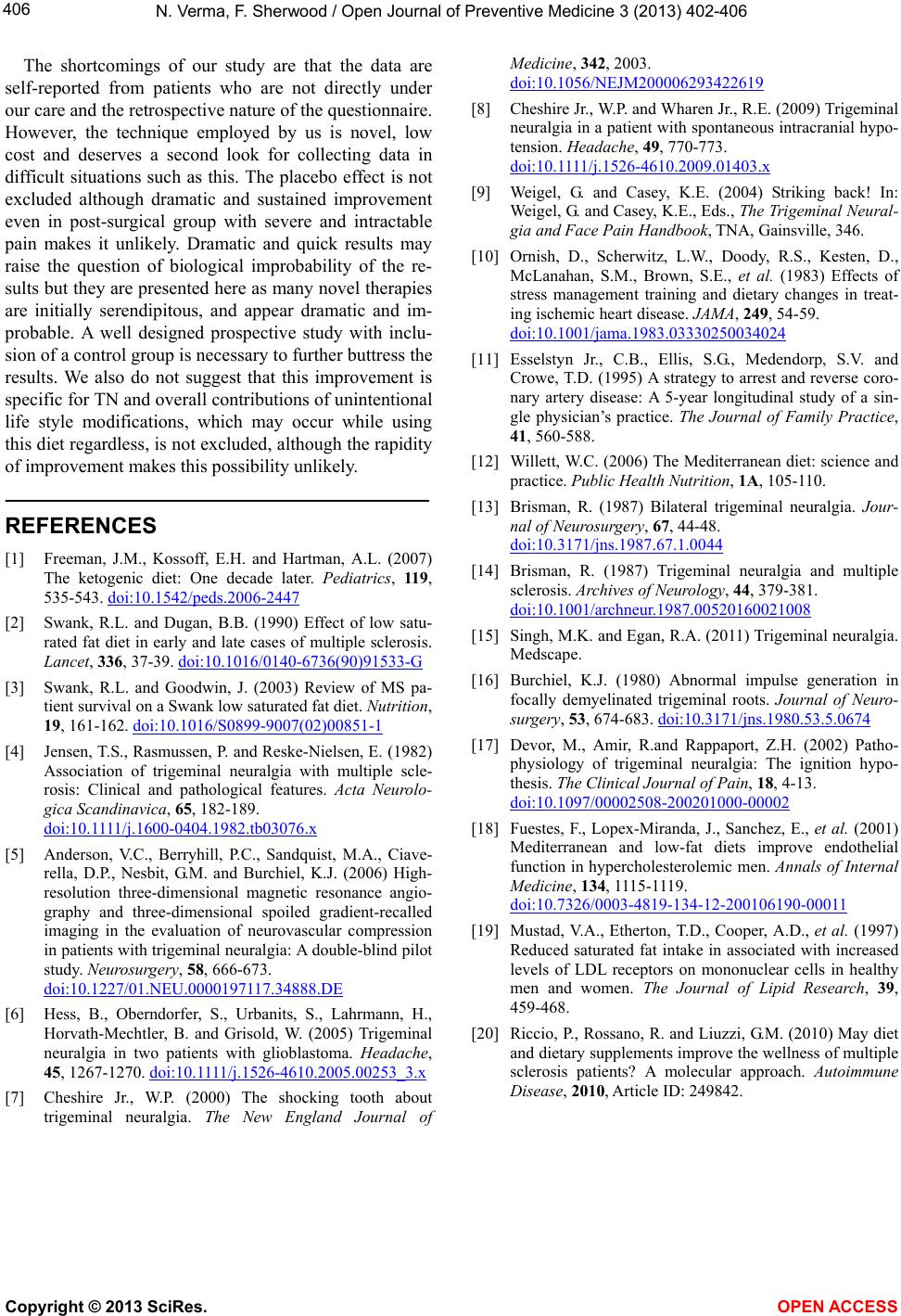
N. Verma, F. Sherwood / Open Journal of Preventive Medicine 3 (2013) 402-406
Copyright © 2013 SciRes.
406
The shortcomings of our study are that the data are
self-reported from patients who are not directly under
our care and the retrospective nature of the questionnaire.
However, the technique employed by us is novel, low
cost and deserves a second look for collecting data in
difficult situations such as this. The placebo effect is not
excluded although dramatic and sustained improvement
even in post-surgical group with severe and intractable
pain makes it unlikely. Dramatic and quick results may
raise the question of biological improbability of the re-
sults but they are presented here as many novel therapies
are initially serendipitous, and appear dramatic and im-
probable. A well designed prospective study with inclu-
sion of a control group is necessary to further buttress the
results. We also do not suggest that this improvement is
specific for TN and overall contributions of unintentional
life style modifications, which may occur while using
this diet regardless, is not excluded, although the rapidity
of improvement makes this possibility unlikely.
OPEN A CCESS
REFERENCES
[1] Freeman, J.M., Kossoff, E.H. and Hartman, A.L. (2007)
The ketogenic diet: One decade later. Pediatrics, 11 9,
535-543. doi:10.1542/peds.2006-2447
[2] Swank, R.L. and Dugan, B.B. (1990) Effect of low satu-
rated fat diet in early and late cases of multiple sclerosis.
Lancet, 336, 37-39. doi:10.1016/0140-6736(90)91533-G
[3] Swank, R.L. and Goodwin, J. (2003) Review of MS pa-
tient survival on a Swank low saturated fat diet. Nutrition,
19, 161-162. doi:10.1016/S0899-9007(02)00851-1
[4] Jensen, T.S., Rasmussen, P. and Reske-Nielsen, E. (1982)
Association of trigeminal neuralgia with multiple scle-
rosis: Clinical and pathological features. Acta Neurolo-
gica Scandinavica, 65, 182-189.
doi:10.1111/j.1600-0404.1982.tb03076.x
[5] Anderson, V.C., Berryhill, P.C., Sandquist, M.A., Ciave-
rella, D.P., Nesbit, G.M. and Burchiel, K.J. (2006) High-
resolution three-dimensional magnetic resonance angio-
graphy and three-dimensional spoiled gradient-recalled
imaging in the evaluation of neurovascular compression
in patients with trigeminal neuralgia: A double-blind pilot
study. Neurosurgery, 58, 666-673.
doi:10.1227/01.NEU.0000197117.34888.DE
[6] Hess, B., Oberndorfer, S., Urbanits, S., Lahrmann, H.,
Horvath-Mechtler, B. and Grisold, W. (2005) Trigeminal
neuralgia in two patients with glioblastoma. Headache,
45, 1267-1270. doi:10.1111/j.1526-4610.2005.00253_3.x
[7] Cheshire Jr., W.P. (2000) The shocking tooth about
trigeminal neuralgia. The New England Journal of
Medicine, 342, 2003.
doi:10.1056/NEJM200006293422619
[8] Cheshire Jr., W.P. and Wharen Jr., R.E. (2009) Trigeminal
neuralgia in a patient with spontaneous intracranial hypo-
tension. Headache, 49, 770-773.
doi:10.1111/j.1526-4610.2009.01403.x
[9] Weigel, G. and Casey, K.E. (2004) Striking back! In:
Weigel, G. and Casey, K.E., Eds., The Trigeminal Neural-
gia and Face Pain Handbook, TNA, Gainsville, 346.
[10] Ornish, D., Scherwitz, L.W., Doody, R.S., Kesten, D.,
McLanahan, S.M., Brown, S.E., et al. (1983) Effects of
stress management training and dietary changes in treat-
ing ischemic heart disease. JAMA, 249, 54-59.
doi:10.1001/jama.1983.03330250034024
[11] Esselstyn Jr., C.B., Ellis, S.G., Medendorp, S.V. and
Crowe, T.D. (1995) A strategy to arrest and reverse coro-
nary artery disease: A 5-year longitudinal study of a sin-
gle physician’s practice. The Journal of Family Practice,
41, 560-588.
[12] Willett, W.C. (2006) The Mediterranean diet: science and
practice. Public Health Nutrition, 1A, 105-110.
[13] Brisman, R. (1987) Bilateral trigeminal neuralgia. Jour-
nal of Neurosurgery, 67, 44-48.
doi:10.3171/jns.1987.67.1.0044
[14] Brisman, R. (1987) Trigeminal neuralgia and multiple
sclerosis. Archives of Neurology, 44, 379-381.
doi:10.1001/archneur.1987.00520160021008
[15] Singh, M.K. and Egan, R.A. (2011) Trigeminal neuralgia.
Medscape.
[16] Burchiel, K.J. (1980) Abnormal impulse generation in
focally demyelinated trigeminal roots. Journal of Neuro-
surgery, 53, 674-683. doi:10.3171/jns.1980.53.5.0674
[17] Devor, M., Amir, R.and Rappaport, Z.H. (2002) Patho-
physiology of trigeminal neuralgia: The ignition hypo-
thesis. The Clinical Journal of Pain, 18, 4-13.
doi:10.1097/00002508-200201000-00002
[18] Fuestes, F., Lopex-Miranda, J., Sanchez, E., et al. (2001)
Mediterranean and low-fat diets improve endothelial
function in hypercholesterolemic men. Annals of Internal
Medicine, 134, 1115-1119.
doi:10.7326/0003-4819-134-12-200106190-00011
[19] Mustad, V.A., Etherton, T.D., Cooper, A.D., et al. (1997)
Reduced saturated fat intake in associated with increased
levels of LDL receptors on mononuclear cells in healthy
men and women. The Journal of Lipid Research, 39,
459-468.
[20] Riccio, P., Rossano, R. and Liuzzi, G.M. (2010) May diet
and dietary supplements improve the wellness of multiple
sclerosis patients? A molecular approach. Autoimmune
Disease, 2010, Article ID: 249842.